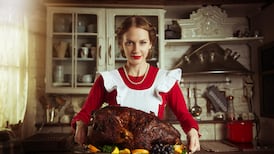The design of the Irish kitchen has been subtly, or in some cases dramatically, changed by the pandemic. As working from home became the new norm, three meals a day had to be conjured up from the contents of the cupboards, fridge and freezer. At the same time, shopping expeditions were often curtailed, to reduce risk, and the “big shop” got bigger.
The ubiquitous tins of chickpeas and tomatoes might have ended up in a proxy larder under the stairs, but what to do with all those extra loaves of bread, butter, cheese and ham for the endless sandwiches? The piles of vegetables and the meat mountains, where to store them?
Walk-in pantries have become one of the most coveted of kitchen design features, but for those of us not in the market for a complete kitchen redesign, electrical appliance retailers have seen a spike in demand for full-height larder fridges, and for chest freezers to put out in a shed or garage.
If it's going in a shed, nine times out of 10, a chest freezer is what you put in, because it's designed to be out there, its mechanisms are protected
"Chest freezers are selling especially well since the lockdowns, as people are keeping a lot more freezer food. They'll normally have a fridge freezer in the kitchen and are realising, 'I need more space, there are more people eating at home and I need more food,'" says Darragh Garvey, product and marketing manager at Harvey Norman.
“There is also a trend where people are upsizing, taking out the fridge freezer, and putting in a larder fridge and a larder freezer. Some people are taking out cupboards and putting a freezer in their utility room.”
So, if you’ve decided to expand your food storage capacity by investing in more freezer space, where should you start? What models should you consider, what features are most useful and how do you get the best performance from your new freezer?
“The first question we ask is, ‘Where is the freezer going?’” Garvey says. “A lot of freezers wouldn’t be suitable for putting in your garden shed, even if it’s insulated, because they have to run at an ambient temperature, and frost can damage them. If it’s going in a shed, nine times out of 10, a chest freezer is what you put in, because it’s designed to be out there, its mechanisms are protected,” Garvey says.
He also recommends checking the energy label on the freezer to see how much it will add to your electricity bill. “It will tell you how many kilowatts a year it is to run, that’s really important. Some of them can surprise you. A €299 larder freezer could be 250 kilowatts per annum and one costing €599/€699 could be around 148 kilowatts per annum.”
Once the door closes and the shelves go in nice and neatly, there's no issue, it's designed to take in as much as it can
The energy label will also disclose the capacity of the freezer, measured in litres. Garvey says that while two freezers might look the same size on the shop floor, the amount of food they can store can differ. “There are differences because of the way the racking and shelving is done inside. Some are cleverer, they get you that extra bit of space.”
The noise the freezer will make when running will also be on the energy label and Garvey suggests choosing one that runs at 50 decibels or less. Another important feature to look for is that the freezer is frost-free. “That means that you’ll never have to defrost it.”
Once you’ve got your new freezer installed, it will take up to 12 hours to get to its recommended temperature setting, so be sure to run down your supplies before you make the switch.
And then it’s time to start filling it again, so is there any truth in the suggestion that freezers run more efficiently when full? “Yes, it’s definitely true,” Garvey says. “The freezer detects how much air is in the cabinet and the more air, the more the motor has to do. If there’s less air, because you’ve filled the freezer, the motor doesn’t have to do as much.”
If you’ve ever wedged another bag of peas into a crammed freezer, and wondered just how much is too much, don’t worry. “Once the door closes and the shelves go in nice and neatly, there’s no issue, it’s designed to take in as much as it can, once it fits within the shelving that’s there.”
Garvey has a useful tip when it comes to freezer maintenance. “We recommend cleaning the door seals at least once a year; don’t use detergent, just warm water. Some detergents can be a bit acidic so they can damage the rubber, and you might find that they wouldn’t seal as well afterwards. If you’re buying a chest freezer, always get one with a key lock, it’s not so that your neighbours don’t nick your food, it’s so once you close that lock, it makes sure the seal is tight.”
A cook’s guide to freezer food

Damien Grey: ‘Nothing longer than three months’
The chef/proprietor of Michelin-starred Liath restaurant in Blackrock, Co Dublin, has an upright freezer in his home kitchen and when asked what’s in it, he says: “Too much! Dumplings, pizzas, sweetcorn and peas, hash browns, lamb chops, and the lonesome ice-pop and fish finger that’s been lost out of the box.”
There’s also a stash of chilli con carne, from a batch cooking session for family dinners. “If you use a freezer properly, it can be your best mate, it saves you a lot of time. We have a fairly busy schedule through the week, we’ve got a lot of football, music, all that sort of stuff. We make dinners up, then fire them in the freezer, if it’s stuff you know that you can freeze.”
So what wouldn’t he freeze? “Any vegetables that have been cooked, don’t bother, and don’t put salad leaves in there. Chicken with a bone in it, like legs, are okay, but chicken breasts don’t freeze that well. The water content is quite high, so when you defrost them, they can be quite chewy.”
Grey has strong feelings on how long to keep food in the freezer, and how to preserve quality. “Nothing should be in the freezer for longer than three months. And you don’t freeze something that’s been cooked and sitting in your fridge for a couple of days. You cook, you cool, you bring it right down to under five degrees, and you freeze straight away.”
But, like most of us, his freezer throws up occasional surprises. “There’s always the mystery box, it doesn’t matter how organised you are, there’s always one or two randoms that get away from you. You pull it out and you go, whew, that’s been there for six months. I wouldn’t eat it, I’d call it a day.”

Aoife Noonan: ‘Freeze bread in slices’
As a professional pastry chef and tutor, as well as a student of nutrition at Masters level, Aoife Noonan is well equipped to know how baked goods fare in the freezer. “You can freeze nearly all breads, cakes and biscuits, and even baking ingredients such as eggs, butter and milk, to prolong their shelf life if they are nearing their use-by dates.
“For eggs, separate your yolks and whites and divide into portions to make it easier when you need specific amounts for a recipe. If you end up freezing a few yolks together or whites together, write the number of eggs on the bag before freezing, or if you don’t know how many eggs you’ve frozen, defrost and weigh them – yolks weigh about 20g each and whites weigh 30g. Add a pinch of salt to your egg yolks to prevent them becoming ‘gel-like’ when defrosted. Egg yolks and whites will keep for six months to a year in the freezer.
“I like to freeze my bread in individual slices, which avoids having to defrost, slice and use up a whole loaf when all you want is a slice of toast. I do this for loaf cakes too, and portion individual slices into reusable sealed bags. I use airtight freezer-friendly stackable containers for biscuits or cookies, with a sheet of parchment paper between each layer to prevent them sticking together.
“If you have a whole iced or frosted cake you need to freeze, portion it into slices and freeze individually to save space; buttercreams and icings freeze particularly well. Breads and cakes will keep well in the freezer for up to two months.”

Aishling Moore: ‘Freezers taint the quality of fish’
Aishling Moore is head chef at Goldie in Cork, a restaurant specialising in sustainable fish cooking, and using the whole fish, scale to tail. “I’d be super reluctant with freezing perfect fresh fish, untreated, at home. Domestic freezers really taint the quality of fish.”
But there are ways to have a supply of fish in your freezer. “I’m a huge fan of freezing smoked haddock. I love having it in the freezer, a smoked haddock risotto is a matter of moments away when I’m craving a seafood dinner without having to go and source the fresh fish.
“Smoked salmon is also handy to have in the freezer, once you plan on cooking it after the fact. It’s great for a fish pie; if you have a little left over, pop it in the freezer.”
Moore has some suggestions for processes that can be applied to fresh fish to make it able to withstand freezing more successfully. “I’d marinate monkfish in a tandoori spice and a little yogurt. Generally that would go into a curry in my house, likewise with pollock. I’d also recommend panko bread crumbing fish before freezing too, the coating also protects the fish.”



















